Details

Toxicology and Risk Assessment
A Comprehensive Introduction1. Aufl.
|
118,99 € |
|
| Verlag: | Wiley |
| Format: | |
| Veröffentl.: | 15.04.2008 |
| ISBN/EAN: | 9780470868942 |
| Sprache: | englisch |
| Anzahl Seiten: | 698 |
DRM-geschütztes eBook, Sie benötigen z.B. Adobe Digital Editions und eine Adobe ID zum Lesen.
Beschreibungen
This new book, written by two outstanding scientists in the field, describes the basic principles of toxic mechanisms and organ toxicity, providing detailed information on specific mechanisms or chemicals for exemplification. The goal is to provide sufficient information that the reader becomes familiar with the basic concepts in toxicology to enable him or her to understand the basic principles in toxicology and to evaluate the risks at given exposures. With this basic understanding the reader also will be able to critically evaluate the available information on a chemical and to identify data gaps. <p>In addition to the introductory chapters the book will offer the following systematic information, presented in six special sections:</p> <ul> <li>Principles in Toxicology</li> <li>Organ Toxicology</li> <li>Methods in Toxicology</li> <li>Risk Assessment</li> <li>Risk Management</li> <li>Toxicity of Chemicals</li> </ul> <p>Fulfilling a demand for such a book, this will be a welcomed introductory text for students and non-experts alike to focus on and understand the principles of hazard identification and risk assessment of toxicants. Relevant to all those studying toxicology, biochemistry, biology, medicine and chemistry, as well as toxicologists in hospitals, universities and in industry.</p>
Preface. <p>List of Contributors.</p> <p><b>1 Introduction to the Discipline of Toxicology</b> (Helmut Greim and Robert Snyder).</p> <p>1.1 Introduction.</p> <p>1.2 The Risk-Assessment Process.</p> <p>1.3 Toxicological Evaluation of New and Existing Chemicals.</p> <p>1.4 Summary.</p> <p><b>2 Principles.</b></p> <p>2.1 Toxicokinetics (Johannes G. Filser).</p> <p>2.2A Phase I Metabolism (Jeroen T.M. Buters).</p> <p>2.2B Drug Metabolism (Leslie Schwarz and John B. Watkins).</p> <p>2.3 Toxicogenetics (Lesley Stanley).</p> <p>2.4 Cytotoxicity (Leslie Schwarz and John B. Watkins).</p> <p>2.5 Receptor-Mediated Mechanisms (Jens Schlossmann and Franz Hofmann).</p> <p>2.6 Mixtures and Combinations of Chemicals (Victor J. Feron and Diana Jonker).</p> <p>2.7 Chemical Carcinogenesis: Genotoxic and Nongenotoxic Mechanisms (Thomas Efferth and Bernd Kaina).</p> <p>2.8 Reproductive Toxicology (Horst Spielmann).</p> <p>2.9 Ecotoxicology: Not just Wildlife Toxicology (Peter Calow and Valery E. Forbes).</p> <p><b>3 Organ Toxicology.</b></p> <p>3.1 The Gastrointestinal Tract (Michael Schwenk).</p> <p>3.2 The Liver (Leslie Schwarz and John B. Watkins).</p> <p>3.3 The Respiratory System (Jurgen Pauluhn).</p> <p>3.4 The Nervous System (Gunter P. Eckert and Walter E. Mu¨ller).</p> <p>3.5 Behavioral Neurotoxicology (Andreas Seeber).</p> <p>3.6 The Skin (Tibor A. Rozman, Myriam Straube and Karl K. Rozman).</p> <p>3.7 The Kidney and Urinary Tract (Helmut Greim).</p> <p>3.8 Toxicology of the Blood and Bone Marrow (Robert Snyder).</p> <p>3.9 Immunotoxicology (Carol R. Gardner and Debra L. Laskin).</p> <p>3.10 The Eye (Ines M. Lanzl).</p> <p>3.11 The Cardiovascular System (Helmut Greim).</p> <p><b>4 Methods in Toxicology.</b></p> <p>4.1 OECD Test Guidelines for Toxicity Tests in vivo (Rudiger Bartsch).</p> <p>4.2A Mutagenicity Tests in vivo (Ilse-Dore Adler).</p> <p>4.2B In vitro Tests for Genotoxicity (Ulrich Andrae and Gunter Speit).</p> <p>4.2.C Strategies for the Evaluation of Genotoxicity (Stephan Madle, Peter Kasper, Ulrike Pabel and Gunter Speit).</p> <p>4.3 Biomonitoring (Michael G. Bird).</p> <p>4.4 Epidemiology (Kurt Ulm).</p> <p>4.5 Omics in Toxicology (Laura Suter-Dick and Thomas Singer).</p> <p>4.6 Introduction to the Statistical Analysis of Experimental Data (Gyorgy Csanady).</p> <p><b>5 Risk Assessment.</b></p> <p>5.1 Mathematical Models for Risk Extrapolation (Jurgen Timm).</p> <p>5.2 Regulations Regarding Chemicals and Radionuclides in the Environment, Workplace, Consumer Products, Foods, and Pharmaceuticals (Dennis J. Paustenbach and Pearl Moy).</p> <p><b>6 Toxicity of Selected Chemicals.</b></p> <p>6.1 Persistent Polyhalogenated Aromatic Hydrocarbons (Kristian W. Fried and Karl K. Rozman).</p> <p>6.2 Metals (Karl-Heinz Summer, Stefan Halbach, Herrmann Kappus and Helmut Greim).</p> <p>6.3 Toxicology of Fibers and Particles (Paul J.A. Borm).</p> <p>6.4 Xenoestrogens and Xenoantiandrogens (Gisela H. Degen and J. William Owens).</p> <p>6.5 Toxicology of Solvents (Wolfgang Dekant and Marion W. Anders).</p> <p>6.6 Noxious Gases (Ladislaus Szinicz).</p> <p>6.7 Animal and Plant Toxins (Thomas Zilker).</p> <p>Index.</p>
"Es gefallt das didaktisch-logische Konzept mit hervorgehobenen Kernaussagen."<br /> BIOspektrum<br /> 04.08<br />
<b>Prof. Dr. Helmut Greim</b>, Institut für Toxikologie und Umwelthygiene Technische Universität München, Germany
TOXICOLOGY AND RISK ASSESSMENT: A COMPREHENSIVE INTRODUCTION <p>HELMUT GREIM, Institut für Toxikologie und Umwelthygiene, Technische Universität München</p> <p>ROBERT SNYDER, Environmental and Occupational Health Sciences Institute, Rutgers, The State University of New Jersey</p> <p>Toxicology is concerned with the health risks of human exposure to chemicals. It describes the adverse effects of chemicals in a qualitative sense, and with evaluating them quantitatively by determining how much of a chemical is required to produce a given response.</p> <p><i>Toxicology and Risk Assessment: A Comprehensive Introduction</i> describes the basic concepts of toxicology, and aims to equip the reader with the skills required to evaluate risks at given exposures. Topics covered include:</p> <ul type="disc"> <li><b>Principles in Toxicology</b>: toxicokinetics including absorption, distribution, metabolism and excretion; the mechanisms that lead to cytotoxicity, carcinogenicity and effects on reproduction; and the toxic effects of mixtures of chemicals</li> <li><b>Organ Toxicology</b>: information on anatomy and physiology of the major organs; why they are specific targets; and the mechanisms of specific chemicals affecting these organs</li> <li><b>Methods in Toxicology</b>: the commonly used methods used for toxicity testing, both <i>in vivo</i> and <i>in vitro</i></li> <li><b>Risk Assessment</b>: the concepts comprising hazard identification, dose-response, and exposure assessment and the different approaches for thresholded and non-thresholded effects. Recent molecular-biological results on cellular responses to genotoxic agents such as DNA-repair, halt of proliferation, and apoptosis that allow assumption of thresholded genotoxic effects are also described</li> <li><b>Risk Management</b>: US and European regulations for chemicals</li> <li><b>Toxicity of Chemicals</b>: the toxic mechanisms and effects of major groups of chemicals</li> </ul> <p><i>Toxicology and Risk Assessment</i> is an essential text for scientists in academia, industry and government agencies who want to understand how our bodies respond to toxicants, and the principles used to assess the health risks of specific exposure scenarios.</p>


















